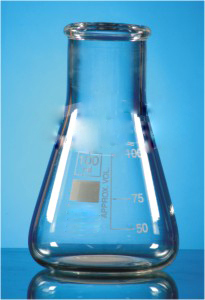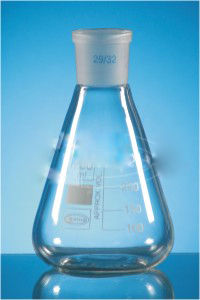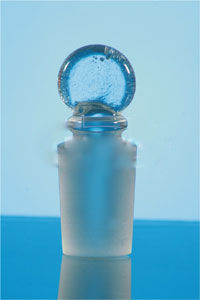Laboratory Erlenmeyer Flasks
Laboratory Erlenmeyer Flasks Specification
- Shape
- Conical (Erlenmeyer)
- Accuracy
- Graduated for approximate volume only
- Features
- Graduated Markings, Wide Flat Bottom, Tapered Neck, Chemical Resistant, Autoclavable
- Power Supply
- Not Required
- Heating Capacity
- Can be heated; use as per glass specification (generally up to 400C)
- Glass Type
- Borosilicate
- Temperature Resistance
- Up to 400C
- Display Type
- None
- Type
- Erlenmeyer Flask
- Dimension (L*W*H)
- Varies depending on capacity (e.g., standard 250 mL: approx. 88 x 88 x 140 mm)
- Equipment Type
- Glassware
- Equipment Materials
- Borosilicate Glass
- Material
- Glass
- Application
- Laboratory Chemical Handling, Mixing, Titration, Solution Preparation
- Capacity (Ltr)
- Typically available in 50 mL, 100 mL, 250 mL, 500 mL, 1000 mL, and other sizes
About Laboratory Erlenmeyer Flasks
Erlenmeyer Flasks
Erlenmeyer Flasks, Wide Neck with graduation DIN 12385.
|
||||
|
||||
|
||||
|
||||
|
||||
|
||||
|
||||
|
||||
|
||||
|
Engineered for Versatility and Precision
Erlenmeyer flasks offer exceptional reliability for laboratory tasks, from chemical handling to titration. Their conical design permits easy swirling of contents without risk of spillage, while the white graduation marks provide approximate volume indication for efficient preparation of solutions. The flasks robust borosilicate glass composition ensures resistance to corrosive chemicals and thermal gradients, making them a mainstay in research, education, and industrial labs.
Advanced Material and Superior Resistance
Constructed from premium borosilicate glass, these flasks withstand temperatures up to 400C and resist most laboratory chemicals, including acids and alkalis. Their durability makes them suitable for frequent sterilization by autoclaving at temperatures up to 121C. The surface remains clear and smooth, ensuring accurate observation and easy cleaning after use, prolonging the lifespan of the glassware.
Comprehensive Range of Sizes and Applications
Available in a broad spectrum of capacities, from 50 mL to 1000 mL and beyond, these Erlenmeyer flasks cater to diverse experimental needs. They accommodate a variety of laboratory procedures, such as solution preparation, chemical mixing, heating, and titration. The option to fit them with a rubber or glass stopper (not included) adds to their convenience for storage and reaction containment.
FAQs of Laboratory Erlenmeyer Flasks:
Q: How should Erlenmeyer flasks with white graduations be used during laboratory procedures?
A: These flasks are designed for tasks like mixing, titration, and solution preparation. The conical shape helps prevent spills during swirling, while the approximate graduations aid in estimating liquid volumes. For precise measurements, use with calibrated equipment.Q: What are the benefits of borosilicate glass in Erlenmeyer flasks?
A: Borosilicate glass offers high resistance to chemicals and thermal shock, allowing safe use with most laboratory reagents and temperature changes. This makes the flasks durable, easy to clean, and suitable for autoclaving and heating up to 400C.Q: When is it appropriate to autoclave these flasks, and what precautions should be taken?
A: Autoclaving is recommended for sterilizing glassware before or after handling biological or hazardous chemicals. Ensure the flask is not sealed (leave any stopper off) to prevent pressure build-up, and do not exceed 121C during the autoclaving cycle.Q: Where can these Erlenmeyer flasks be used effectively?
A: These flasks are suited for laboratories in schools, universities, research institutes, and industrial settings. They are ideal for general chemical handling, solution preparation, and controlled heating or mixing applications.Q: What stopper options are compatible with these flasks, and are they included?
A: The flasks can be fitted with either rubber or glass stoppers for secure closure, but these stoppers are not included and need to be purchased separately based on flask neck size.Q: How accurate are the volume markings on these Erlenmeyer flasks?
A: The white graduation marks provide approximate measurements and are intended for general laboratory use. For experiments requiring precise volume, use additional volumetric equipment such as burettes or pipettes.Q: What process should be followed to safely heat these flasks?
A: Gradually heat the flask using a laboratory burner or hotplate, ensuring compatibility with heating apparatus. Avoid rapid temperature changes to prevent thermal shock, and do not exceed the 400C temperature limit as specified for borosilicate glass.

Price:
- 50
- 100
- 200
- 250
- 500
- 1000+
More Products in LABORATORY GLASSWARE Category
Graduated Pipette
Glass Type : Borosilicate glass
Application : Liquid measurement; used in laboratories for transferring precise volumes
Type : Graduated pipette for liquid handling, Other
Material : Glass
Temperature Resistance : High thermal and chemical resistance (depends on glass quality)
Equipment Materials : Durable glass
Measuring Cylinder Hexagonal Base
Glass Type : Borosilicate
Application : Laboratory Liquid Volume Measurement
Type : Other, Measuring Cylinder
Material : Borosilicate Glass
Temperature Resistance : Up to 250C
Equipment Materials : Glass
Flasks, Conical, (Erlenmeyer) DIN 12387
Glass Type : Clear borosilicate glass
Application : Laboratory experiments and measurements
Type : Other, Flask
Material : Glass
Temperature Resistance : Resistant to high temperatures and thermal changes
Equipment Materials : Borosilicate glass
Stopper, Solid: Penny or Flat Head
Glass Type : Borosilicate or Soda Lime Glass
Application : Sealing laboratory flasks, bottles, tubes
Type : Other, Stopper, Solid
Material : Glass
Temperature Resistance : Typically up to 250C, chemical and heat resistant
Equipment Materials : Borosilicate or Soda Lime Glass
GST : 06ACOPS0805K1ZD
|
 |
SINGHLA SCIENTIFIC INDUSTRIES
All Rights Reserved.(Terms of Use) Developed and Managed by Infocom Network Private Limited. |


 Send Inquiry
Send Inquiry





